 Five top money saving gardening tips
Five top money saving gardening tips
Source: http://www.thisismoney.co.uk/money/bills/article-1725752/Five-top-money-saving-gardening-tips.html
If you’ve been left green with envy by the Chelsea Flower Show’s top plots, why not create one in your own back garden?
It’s a myth that you need to break the bank to make your garden spectacular, given a little time. Here are our top five money saving tips for a blooming beautiful garden:
1. Incredible edibles
Money doesn’t grow on trees, it’ll be growing in a vegetable plot this summer. It’s the allotment gardener’s best kept secret: growing your own really does save cash.
Garden guru Alan Titchmarsh says budding gardeners should invest in growing tomatoes.
The green-fingered aficionado says: ‘Church stalls, car boot sales and school fayres are all good places to find surplus plants being sold off cheaply.
‘There are so many varieties out there it can be hard to pick just one, but good allrounders are Gardeners Delight, Ailsa Craig, Cordiblue and Tumbling Tom. Keep them well watered and watch for the flowers – flowers mean fruit, and fruit means your saving has begun!’
It’s hard to get better than home grown fruit and veg for flavour and goodness. The average lettuce from the supermarket contains up to 11 pesticides, while many pre-packaged salads are washed with chlorine.
It’s now a bit late for tomatoes but there’s still time to plant plenty of salad vegetables: lettuce, spring onions, radishes, rocket. And start planning ahead next year for carrots, peas, sweetcorn, and more.
2. Plan ahead
It might be obvious, but a little bit of forward planning goes a long way in savings.
This month, plant perennials and biennials for next spring. June is also the last month to be planting seeds for summer-producing vegetables.
We recommend planting seeds for autumn crops like lettuce, spinach, radish, kale, carrots and leeks to save a packet.
3. Don’t fork out for fertiliser
It’s essential your seedlings and veg plots are able to grow in good quality soil. We have a few frugal alternatives to spending twenty quid on a large bag of fertiliser.
Collect fallen leaves when they are wet, then store in bin bags for two years. The longer the better. The result is a nutritious leaf mulch which can be used to cover your most prized plants.
If you’ve got access to a pond, the algae growing on top can be used as a rich alternative to shop-bought fertiliser.
4. Be water wise
This year’s scorching spring has been a nightmare for British gardeners keen to keep their gardens hydrated.
Sprinkler
Around a third of UK homes are on a water meter, and regardless of the cost we should all do our bit to keep water usage to a minimum.
Don’t fear if the hot weather has left you with a brown lawn. Lawn shoots are usually the first garden feature to show drought stress, because they have the most shallow roots. The lawn will quickly recover once it rains.
Winter rain is still stored in the soil, and for plants such as trees, shrubs and climbers with large roots there is still plenty there.
Guy Barter, from the Royal Horticultural Society, gives us his water-saving advice: ‘Waste water from the kitchen is highly suitable for watering gardens, grey water from the bathroom is usually satisfactory, but perhaps best not used on edible crops.’
5) Being ethical is easy
Reusing household rubbish is a great way to help the environment while keeping in pocket.
Save your produce baskets – cherry tomatoes, berries, mushrooms – and use them to plant seedlings. Don’t be afraid to ask your local supermarket or greengrocer for wooden or plastic crates which can be used as planters or for winter storage.
The little plastic cups at the water cooler can also be useful for seed starting plots.
A blooming garden can also help to keep bills down. A study by the Royal Horticultural Society found that plants can reduce energy costs in winter by providing shelter and insulation. In the summer they cool down the air in towns and cities, so get those urban gardens growing!
And finally…No garden? No excuse!
Even city-dwellers can get green fingered this summer. Use a windowsill to create a miniature salad-garden, or fill a light area with potted flowers and fruit.
If you’re short on light, try placing a small amount of aluminium foil on the wall next to the plant. This will help reflect more light on to your indoor greenery.
Indoor plants are proven to have health benefits, as well as being an inexpensive decoration for the home. They reduce indoor air pollution and carbon dioxide levels.
Research estimates that people who live and work in a city spend 90% of their day indoors, so having a few potted plants indoors is all-important for urban workers.
A study by Sydney University in Australia has found that a few shrubs in the office can even improve employee efficiency by creating a healthier working environment.
